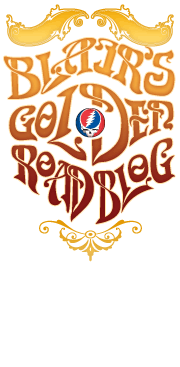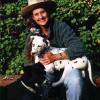In my blog a couple of weeks ago about my favorite cover versions of Grateful Dead songs, I mentioned the Bay Area acoustic band Wake the Dead, who play a unique fusion of (mostly) Irish traditional music and Dead tunes. I had liked several album tracks of theirs through the years, but had never seen them live—amazing since they’ve been a local fixture for a dozen years.
After that blog came out, however, the group’s leader, Danny Carnahan, was nice enough to invite me to the band’s annual Halloween show (held on October 30 this year) at the wonderful, still newish Freight & Salvage folk club in Berkeley—their tenth such celebration. I already had tickets to see 7 Walkers on Halloween night at the Great American Music Hall in San Francisco, so I thought this would be an excellent opportunity to see two very different bands interpreting Grateful Dead songs on consecutive nights.
When we arrived at the Freight on that Sunday evening a little before showtime, every seat in the 440-capacity venue was filled, so we grabbed a spot in the rear standing-room area. This ended up being a fortuitous turn of events, as we got to dance the night away to Wake the Dead’s highly infectious Irish dance numbers and GD favorites, while the rest of the respectful and enthusiastic crowd enjoyed the band from the comfort of their seats. I’ll never understand how people can just sit there and listen to this kind of music without shakin’ it a little. In the immortal words of Gene Kelly: “Gotta dance!”
It’s hard to explain what makes Wake the Dead so special. They’re not really a jam band in the sense of playing lots of long improvisational passages. Rather, they are extremely skilled and disciplined players who have figured out a way to move seamlessly from, say, a verse of a Dead tune, into a passage of Irish music, sometimes in a different key and cadence, back into the Dead song, and so forth, turning on a dime. With Dead songs we all know so well, this can be a bit jarring at times, yet they always manage to pull it off and take the songs in fascinating directions. A version of “Cumberland Blues” went into the traditional “Cumberland Reel,” and all of a sudden you couldn’t miss the Dead’s close connection to their English and Irish roots. “St. Stephen” (played for All Saints Day, mandolinist, singer and occasional emcee Paul Kotapish announced), was linked to a song called “The Old Bush.” One of the most moving parts of the show came when Maureen Brennan played a verse of “Box of Rain” solo on Celtic harp before the band joined in. And Kevin Carr’s uilleann pipes, pennywhistle and fiddle carried some of the melodic riffs and runs that Jerry used to play—how refreshing! (Carr also led a group of pipers and drummers in a selection of Galician folk numbers in the lobby during the intermission—Garcia’s father was born in that part of Spain.) The musicianship across the board was stunningly good and the vocals up there with the best folk/bluegrass groups.
The bands’s interesting cover choices weren’t limited to Dead tunes, either: “Bird Song” floated into Buffalo Springfield’s “Bluebird” before returning to “Bird Song” (with plenty of Emerald Isle vibe laced through it all). And how about this medley: “White Rabbit” (sung fantastically by Sylvia Herold) > “Banks of Lough Gowna” > “Friend of the Devil” > “The Reunion.” They also whipped out cool takes on The Youngbloods’ “Darkness, Darkness” and “Get Together” and, much to my delight, “Werewolves of London” (customized for the Berkeley audience with a reference to the restaurant Chez Panisse, instead of Zevon’s “Lee Ho Fook’s”).
A pair of “special guests” livened up the evening for a few songs, too: an enormous skeleton head, torso and arms manipulated by a puppeteer danced gracefully in the aisle on one side of the club, while on the aisle on our side came a 10-foot Drooling Ghoul—both had appeared in Grateful Dead Mardi Gras parades past. At least we got to dance with somebody — that ghoul had some moves!
All in all, it was a great night of music from beginning to end. What an inventive and inviting context for Grateful Dead music Wake the Dead have created. I’d buy a CD of that concert right now!
The 7 Walkers show the next night couldn’t have been more different. That band is as loose and funky as Wake the Dead is tight and precise. Unlike the sedate Freight crowd, the Dead Heads at the Great American Music Hall were up and dancing the whole night, most decked out in Halloween getups. Onstage, Bill Kreutzmann was sporting a barely visible touch of black-and-white skeleton makeup, bassist Reed Mathis donned a bird mask with long beak for the first several numbers, keyboard/harmonica/trombone master Matt Hubbard wore a simple Mardi Gras mask most of the evening, and Papa Mali—well, with his long dreads, big glasses and Fedora, he always looks a bit like he’s in costume. The entire back wall of the stage, from floor to ceiling, was festooned with a wildly psychedelic tie-dye that seemed to pulsate in the lights. Then lasers shot beams of color from just above the stage, across the dancefloor to the back balcony; mindbending!

Photo: Regan McMahon © 2011
This was my first time seeing Reed Mathis, who was 7 Walkers’ original bass player, before his commitment to his main band, Tea Leaf Green, forced him to drop out of the Walkers shortly after the group cut its eponymous debut album. His replacement, New Orleans legend George Porter Jr., wasn’t available for some of the shows on 7 Walkers’ summer and fall tours, so Mathis filled in when he could, and at other shows sousaphonist Kirk Joseph (of the Dirty Dozen Brass Band) joined their ranks. Mathis was a monster! He has a tremendous amount of youthful energy and I felt he really brought out the jamming side of the band. He used a pedal on some songs that lets his bass take on a more guitar-like quality, so in some very exciting passages he would double Papa Mali’s lead guitar line or play sturdy counterpoint in a high register—very cool and trippy. I’ve also really come to love Papa Mali’s playing, both on slide (a Gibson SG) and regular lead and rhythm (a well-worn Strat). This guy, who is not from the Garcia School, nevertheless is clearly a kindred spirit with loads of skill and imagination.
The band’s originals, written by Papa and Robert Hunter, have gotten even better with age. Songs such as “Sue from Bogalusa,” “7 Walkers,” “New Orleans Crawl” all became potent jamming vehicles, and both “King Cotton Blues” and “Evangeline” (my favorite) were moody and powerful. Bill K. says that Hunter has delivered a whole new batch of lyrics to be set to music and confirms that a new album will come out next year. Yay!

Photo: Regan McMahon © 2011
Because no one in the band—except Billy, of course—sounds much like the Grateful Dead, 7 Walkers’ interpretations of Dead tunes have their own sound. So even though their “Bird Song” can be as far-out as you’d hope for, it doesn’t mimic the Dead particularly. Same with their peppy “He’s Gone,” which they really nailed and which led to a highly original jam. Papa did a nice job with “Wharf Rat” at the end of the evening, and the band sprinkled in dynamic versions of songs the Dead did, including “I Know You Rider,” “Big Railroad Blues,” “Nobody’s Fault But Mine” and a killer “Goin’ Down the Road.” They played a few other cool covers, too: Dr. John’s “Walk on Gilded Splinters,” Dylan’s “Positively Fourth Street” (which included an appearance by a rail-thin woman dressed like Blonde on Blonde-era Dylan—with giant ’fro and shades—miming a harmonica solo actually played by Hubbard) and my second “Werewolves” in two nights, this one jammed out very nicely. The group also inserted an instrumental slice of George Harrison’s “Within You Without You” into the jam that came out of John Lee Hooker’s rockin’ “Bottle Up and Go.”
I love the energy of this band and the broadness of their repertoire. They simultaneously satisfy my craving for Dead, blues, New Orleans music and good ol’ rock ’n’ roll, while also presenting a bucketload of new tunes that build on those traditions and take them further (no pun intended). Dancing happily with a few hundred ecstatic Heads to one great song after another, I kept thinking, “This is what it’s all about!” And every time I see Billy play, I’m reminded what a true original he is, and why he’s still my favorite drummer.

Photo: Regan McMahon © 2011




